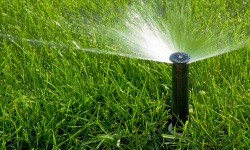
31 Oct It’s Time To Winterize!
Shutting Off the Irrigation System!
Late October or November usually brings Indian Summer, unseasonably warm, dry weather. It’s a great time to stroll around your property and make plans to winterize it. At Fertilawn, we offer deep root fertilization, irrigation shutdown, shrink wrapping, and more. We have over 40 years of doing this for customers, and we’d like to think we are the most knowledgeable professional company on the East End for home winterizing. For reference, here’s an article from Cornell University Cooperative Extension for a guide on what to look for when hiring a contractor and other DIY tips.
When to shut down your irrigation varies. Seasonal weather patterns, soil moisture levels, and homeowner practices are all considered. One thing is for sure: it should be done before the first frost risk, which here on the East End can usually occur in November. Once the irrigation is turned off, it is essential to winterize it to prevent damage from freezing temperatures. This process includes draining pipes, disconnecting hoses, and protecting heads and other fixtures.
Over the years, I have consulted many homeowners on how to do this necessary task. Honestly, most of them end up hiring us to do the winterizing because of its reasonable cost and the peace of mind that it is being done correctly. After all, repairs on a broken irrigation system can be $500 to $1,500 or even higher, depending on the damage. Homeowners have found that our combined services is a worry-free, one-stop shop to take care of their homes during the off-season. Call me at 631-728-5815 for info.
Preparing Your Plants and Trees
There are several ways to ensure your plants and trees will safely make it through the icy cold months.
I want to start with one of the most frequently asked questions I receive, “What do I do with my roses?” The answer can be simple and complex at the same time. The process depends on whether they are in the ground or pots. Call me, and I’ll answer any questions you may have. If you’d like to read some worthwhile information on winterizing roses, check out this article from the American Rose Society.
In general, there are some critical steps to help ensure your plants and trees survive the winter months:
1)Water well. Do a deep watering before the ground freezes.
2)Lay down mulch. Spread mulch around plants and trees about 2” to 3” deep.
3)Prune carefully. Trim dead and damaged branches. Do not do a hard cut.
4)Wrap trees. Use burlap or tree wraps to protect susceptible trees.
5)Cover perennials. Use frost cloths to shield from wind and cold.
6)Move potted plants indoors. If the pots remain outside, consider insulating them with bubble wrap or burlap to protect the roots.
7)Prepare soil. Add a layer of compost. Do not fertilize.
8)Monitor regularly. Periodically check plants and trees for signs of damage or stress. If you cannot do this, please call me (631-728-5815), and we’ll keep an eye on your property throughout the winter.
9)Be careful with de-icing. Watch your salt applications, as the run-off could adversely affect your plants.
Pollinator and Butterfly Gardens
If you are making winter preparations for your garden, remember that doing less is sometimes more beneficial. This U.S. Fish and Wildlife Service article provides excellent tips for winterizing your pollinator garden.
Gordon Andrews
Owner
Fertilawn
